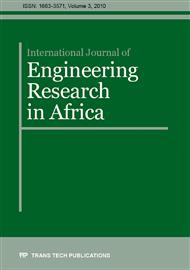[1]
Rural energy: improving energy supplies for 2 billions people – a World Bank best practice paper, World Bank report n° 15912, (1996).
Google Scholar
[2]
Y. Schenkel, M. Temmerman, An overview of wood energy in developing countries, Wood Energy 7 (2002) 32-35.
Google Scholar
[3]
M. Parikka, Global biomass fuel resources, Biomass & Bioenergy 27 (2004), 613-620.
DOI: 10.1016/j.biombioe.2003.07.005
Google Scholar
[4]
P. D. Grover, S. K. Mishra, J. S. Clancy, Development of an appropriate biomass briquetting technology suitable for production and use in developing countries, Energy Sustain. Dev. 1 (1984), 45-48.
DOI: 10.1016/s0973-0826(08)60015-0
Google Scholar
[5]
W. Xutao, Z. Bailiang, Application and problems of Biomass Briquetting Densification Fuel (BBDF) technology in China, in: D. Y. Goswami and Y. Zhao (Eds. ), Proceedings of ISES world congress 2007 (Vol I – Vol V), Springer, Berlin & Heidelberg, 2009, pp.2458-2461.
DOI: 10.1007/978-3-540-75997-3_498
Google Scholar
[6]
S. C. Bhattacharia, M. Augustus Leon, Md. Mizanur Rahman, A study on improved biomass briquetting, Energy Sustain. Dev. 6 (2002), 106 – 110.
Google Scholar
[7]
P. D. Grover, S. K. Mishra, Biomass briquetting: technologies and practices, Food and Agriculture Organization of the United Nations, Bangkok, (1996).
Google Scholar
[8]
P. D. Grover, S. K. Mishra Eds., Proceedings on the international workshop on biomass briquetting – New Delhi (India), 3 – 6 April 1995, Food and Agriculture Organization of the United Nations, Bangkok, (1996).
Google Scholar
[9]
H. A. M. Knoef, Methodologies and experiences of BTG, in: C. Collivignarelli (Ed. ), The role of appropriate technologies in cooperation projects, Aracne editrice s. r. l., Rome, 2007, p.147 – 182.
Google Scholar
[10]
M. Temmerman, A. Barrio – Smith, F. Dubois, Y. Schenkel, Biomass nuts as a new domestic fuel for developing countries, in: W. P. M. Van Swaaij, T. Fjällström, P. Helm, A. Grassi (Eds. ), Proceedings of the 2nd World Biomass Conference - Biomass for Energy, Industry and Climate Protection, Vol. II, ETA, Florence, and WIP, Munich, 2004, p.2493.
Google Scholar
[11]
R. Stanley, Fuelling development, Boil. Point 43 (2003) 13 – 14.
Google Scholar
[12]
A. Mazzù, Study, design and prototyping of an animal traction cam based press for biomass densification, Mech. Mach. Theory 42 (2007) 652 – 667.
DOI: 10.1016/j.mechmachtheory.2006.06.006
Google Scholar
[13]
D. Cattaneo, A. Mazzù, S. Sorlini, P. Zambetti, Study of appropriate technologies for production and utilisation of biomass briquettes in developing countries, in: W. P. M. Van Swaaij, T. Fjällström, P. Helm, A. Grassi (Eds. ), Proceedings of the 2nd World Biomass Conference - Biomass for Energy, Industry and Climate Protection, Vol. II, ETA, Florence, and WIP, Munich, 2004, p.2522.
Google Scholar
[14]
A. Mazzù, S. Sorlini, P. Zambetti, Experimentation of an appropriate technology of biomass recovery for artisanal food transformation in Senegal, in: W. P. M. Van Swaaij, T. Fjällström, P. Helm, A. Grassi (Eds. ), Proceedings of the 14th European Biomass Conference & Exhibition - Biomass for Energy, Industry and Climate Protection, ETA, Florence, and WIP, Munich, (2005).
Google Scholar
[15]
ILCA Bulletin, No 14, December (1981).
Google Scholar
[16]
D. Bourzat, M. R. Goe, L'animal, force de travail dans les systèmes oasiens, Option Méditerranéennes, Sér. A/No 11, (1990).
Google Scholar
[17]
A. Mazzù, Progetto di una pressa per la densificazione delle biomasse adatta ai paesi in via di sviluppo, in: G. Belingardi and G. Curti (Eds. ), AIAS 2009 Atti del XXXVIII Convegno Nazionale, Politecnico di Torino, Turin, (2009).
DOI: 10.4129/cns2008.138
Google Scholar
[18]
Solid biofuels - Fuel specifications and classes, CEN/TS 14961: 2005 standard. Appendix As a preliminary step for an optimised briquette – making machine design, experimental tests were carried out for characterising the different biomass mechanical behaviour in compaction; in particular, they were aimed at obtaining some important parameters such as the minimum pressure value for biomass particles agglomeration, the variation of biomass volume versus applied pressure, the effect of biomass type and particle dimensions. The testing apparatus was a very simple 36 mm cylinder lying on a bed of springs, described in.
Google Scholar
[12]
it was not a sophisticated system, but it provided sufficiently accurate results for the purpose intended. Some biomasses, with different particle size, were tested. A direct correlation was observed between the maximum applied pressure, the final briquette density and the briquette quality; moreover, it was shown that the final density of good quality briquettes depended on the biomass type, varying from 0. 74 – 0. 85 g/cm3 for straw to about 1 g/cm3 for grass, but, on the other hand, a maximum compaction pressure of 580 bar was sufficient with all biomasses for obtaining good briquettes. The tests showed that dry biomass compaction can be divided into two steps: first, the biomass undergoes a large volume reduction, with low opposing pressure: this step can be limited to an applied pressure of about 40 bar; subsequently, a further slight volume reduction follows, whilst the opposing pressure rapidly grows. The biomass relative volume (Vrel) corresponding to 40 bar pressure is variable, due to differences in biomass characteristics and particle size, but when this pressure is exceeded, the curves have similar shapes, although they are differently positioned on the abscissa. This suggested that a unique mathematical relationship could model the behaviour of different kinds of biomass, as long as a parameter for biomass variability was allowed: the obtained relationship was Equation (1) as in this paper.
Google Scholar


